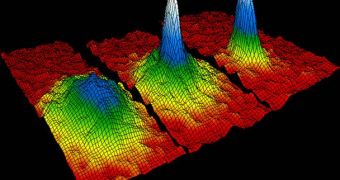Since the famed physicist Albert Einstein devised the General Theory of Relativity, the scientific community has been living a perpetual race to demonstrate it over and over again. Despite decades of confirmations, some experts still want to make sure that Einstein got it right, and that there aren't any exceptional cases in which the overall theory does not apply. Measuring gravity is tricky, therefore it is done in special chambers. A new such device, augmented by a quantum trampoline, was recently built in France, NewScientist reports.
Ensembles of supercold atoms known as Bose-Einstein Condensates (BEC) are usually used to measure gravity, when placed inside a vacuum chamber. The condensates behave in a peculiar, quantum-mechanical wave-like fashion, therefore they interact with each other, creating what are known as interference patterns. By using an advanced interferometer to analyze the patterns – which are dictated directly by the paths individual atoms take as they fall –, the investigators can determine the immediate effect that gravity has on the BEC.
The thing that makes such a research difficult is the fact that the most precise measurements can only be conducted on ensembles that fall on a long distance. But, the longer the fall, the higher the chances that the BEC will disintegrate, rendering the scientific effort useless. “The longer your interferometer, the more precise is your measurement. But you are limited by the size of your apparatus,” Thomas Bourdel, who is an expert at the Palaiseau, France-based Charles Fabry Institute of Optics, explains.
To overcome this obstacle, physicist Philippe Bouyer, also from the Institute, has devised a “quantum trampoline,” an instrument that is meant to prolong the fall time of the BEC, while also keeping the ensembles together. By tuning a highly precise, ultra-fast laser to the necessary parameters, the scientist was able to basically split the wave of BEC in two, making some of the atoms bounce back upwards. On their descent, they would be further split in two, and so on, until the components would finally form an interference pattern. Details of the achievement are published in the journal arXiv.
Bouyer admits that the atom interferometers other physicists use are, at this point, far more precise in their measurements than his laser trampoline. He believes, however, that now, once proof-of-concept has been achieved, he and his team will be able to increase the accuracy of their method by using, for example, lighter atoms and further tunings of the laser.

 14 DAY TRIAL //
14 DAY TRIAL //